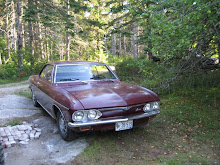I just read a newspaper account of how Bob Lutz, GM's Vice-Chairman of the Board, insists that the current management of GM is "not the problem." Hmm... let me think about this.
Lutz may be right because the GM Board is the problem. Rick Waggoner may be the perfect leader for GM as it is currently constituted - indeed, as it has been constituted for decades. He clearly takes a lot of the heat off the Board and comforts them with his language and actions. What he has not done -with the full support of the GM Board - is produce automobiles that make me want to buy from GM.
GM has a long list of constituents it blames for the precipitous drop in sales: dealers [too many], credit sources [people can't get loans], the general economy and yes, themselves [yes, maybe we built too many pickups and SUV's for the past decade]. Deflectiing blame is not the hallmark of an exciting automobile company.
Too many dealers? You signed them up. Investors would not have signed on is they did not think they had a market. Customers bought cars from them. GM mandated minimum sales numbers for inventory - so who's to blame here? The same investors often own multiple dealerships with GM and "import" brands. It's not the handsome building that sells a car, it's the car itself. Dealer service tied up in warranty claims does not make for a happy customer -right?
And don't take any pride in the J. D. Powers ranking of Buick for quality; their models have been the same boring cars for 5-8 years. Of course they're good - you've had time to get it right. But what it you got it right at the start? I got a ride in a Chevy Impala the other day from a diehard Chevy fan, a vet from upstate New York. He's a tall guy and he fit nicely into the car. It was competant but nothing, absoutely nothing, made me forget the awful Impala and Malbu of 2 years ago that I rented. Yes, I know they've changed, but not once underway.
Corporate boards hold management accountable in several ways, and dividend checks and stock valuations are only one measure. When you look down the pike and you hear only 1 model, the elusive and now very unappealing Chevy Volt, touted as your savior, what does that tell you? The failure of GM's management is to produce excitement around their automobiles and trucks.
I still have and drive routinely, ini all weather, a 1966 Corvair Monza Coupe. It is a joy to get behind the wheel, no matter how short the drive. I wish I had reasons to drive further whenever I'm in it. Get it? I look for an excuse to drive the car!!! There's nothing in the GM lineup right now - even the Corvette - that makes me want to do that. When I need a truck, I use my '66 Land Rover because it is true to the philosophy behind work vehicles - GM's trucks are not. Local fishermen have to search out genuine work trucks from Chevy The options considered vital on passenger cars mean nothing to them. And they'd be very happy to pay less for less standard equipment, too.
These are failures of leadership, from the Board on down to management. The GM system simply does not work anymore. Now don't get me started on Chrysler and Ford.




